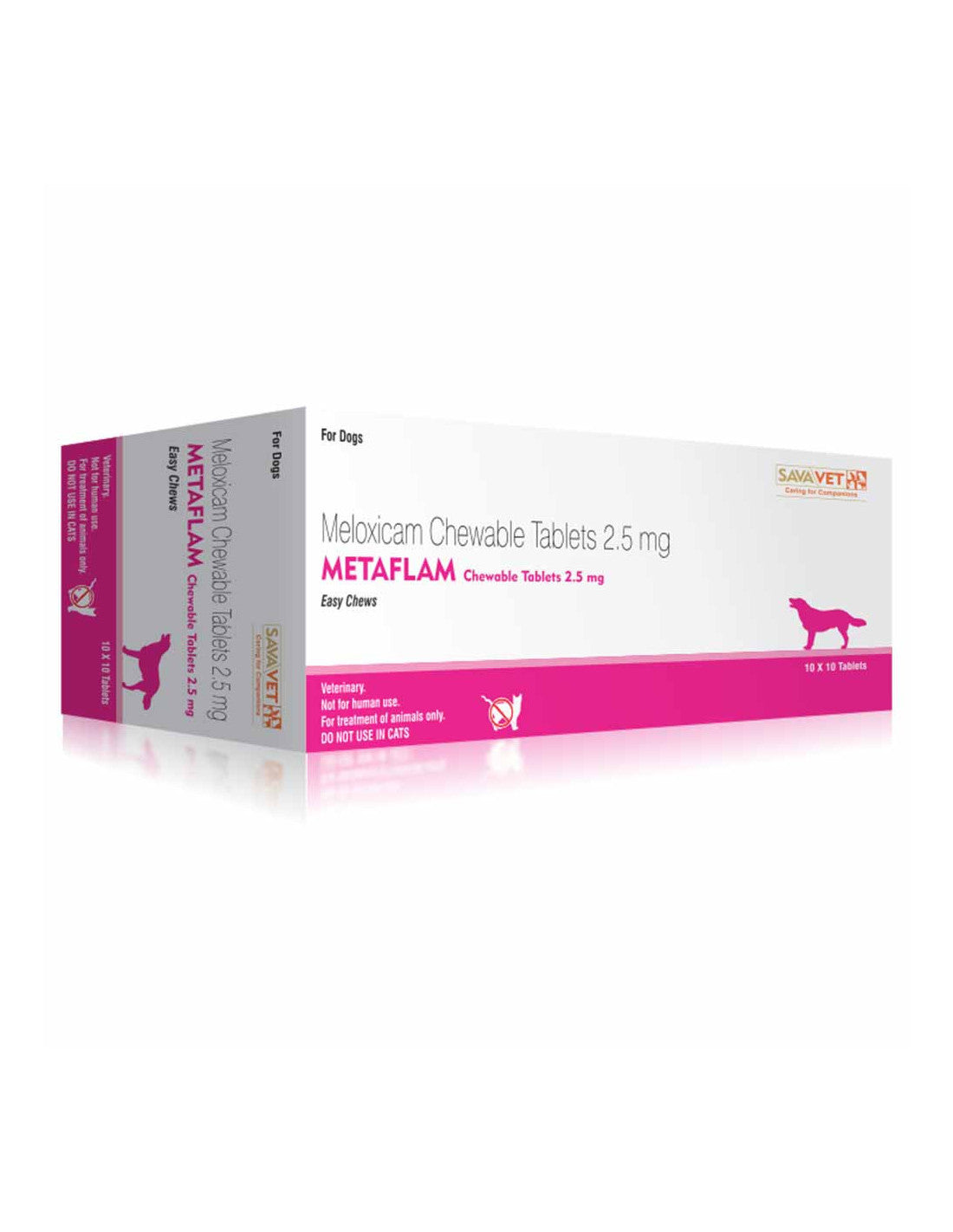Metacam(Meloxicam) Tablet
Generic
Meloxicam(Generic Equivalent To Metacam)

Meloxicam(Generic Equivalent To Metacam)

Metacam is an NSAID, or non-steroidal anti-inflammatory drug, in the oxicam class. It is a selective COX-2 inhibitor, meaning it does not affect COX-1. Cyclooxygenase, or COX, is a family of enzymes called isozymes. Both COX-1 and COX-2 produce prostaglandins, which are lipids in the cells of the body that have hormone-like effects and promote pain and inflammation. COX-1 and COX-2 are found in different cells of the body. Evidence shows that inhibiting COX-2 but not COX-1 may reduce the GI side effects typically associated with non-selective COX inhibiting NSAIDs.1
Metacam is available in tablets for human use, but the doses of those tablets are far too high for use in dogs (with the possible exception of giant dog breeds). Veterinary Metacam is typically found in a flavored suspension with a special oral syringe for accurate dosing. The oral suspension is available in two strengths: 0.5 mg/mL and 1.5 mg/mL. It’s important that you use the proper strength for your dog to avoid overdosage.
Brand names of veterinary Metacam include Metacam, Meloxidyl, and Loxicom. Other generic veterinary forms may be available. Never give your dog human Metacam without specific dosing instructions from your veterinarian.
Uses for Metacam for Dogs
Metacam is sometimes used to relieve pain and reduce inflammation associated with conditions such as osteoarthritis. It is often used to reduce pain and inflammation in order to promote healing and recovery after surgery or injury.
Metacam is typically administered to dogs as a once-daily dose of 0.1 mg/kg (0.045 mg per pound). The initial dose may be doubled at the vet’s discretion.2 Fortunately, Metacam solutions for dogs will typically come with a syringe for dosing according to the dog’s body weight.
Shake the solution well, then draw up the dose for your dog’s weight (or the dose your vet recommends) into the provided syringe. The solution can be put directly into the dog’s mouth or added to food. When adding Metacam to dog food or treats, make sure your dog eats the entire portion of food to ensure adequate dosing. Giving this drug with food may decrease the chances of gastrointestinal upset.
Side Effects of Metacam for Dogs
The potential side effects of Metacam are essentially the same side effects of other NSAIDs.
Signs of Negative Metacam Effects in Dogs
• Vomiting (possibly with blood)
• Diarrhea (possibly with blood)
• Decreased appetite
• Gastrointestinal ulceration and bleeding
• Black, tarry stools (digested blood in stool)
• Kidney damage
• Liver damage
• Prolonged or unexplained bleeding (abnormal clotting)
• Central nervous system issues (uncommon)
If side effects occur in your dog while giving Metacam, stop the medication and contact your veterinarian right away. Bring your dog to a veterinarian immediately if you notice profuse bleeding, extreme lethargy, sudden collapse, or other serious signs of illness.
Considerations Before Giving Dogs Metacam
Your veterinarian might recommend general labs tests to assess your dog’s organ functions and overall health before prescribing Metacam. These tests could reveal underlying liver or kidney issues that could be made worse by Metacam therapy.
Some medications should not be taken at the same time as Metacam. Other NSAIDs (such as aspirin, carprofen, Metacam, deracoxib, and others) should be stopped before starting Metacam unless your vet recommends otherwise. Using multiple NSAIDs at the same time increases the risks of side effects such as vomiting, diarrhea, GI ulceration or bleeding, liver or kidney damage, and abnormal bleeding. The same adverse effects may occur from steroids (such as prednisone and cortisone) along with Metacam. If your dog is on NSAIDs or steroids, your vet will recommend a wash-out period of up to a week before starting your dog on Metacam
Dogs on long-term Metacam treatment will need to be routinely monitored. Monitoring typically includes blood tests every three to six months to make sure there is no damage to the organs. It is also important to bring your dog for routine physical examinations as recommended by your veterinarian. This will allow your vet to look for Metacam-related damage as well as underlying conditions that can be made worse by continued Metacam use.
Talk to your vet if you don’t think Metacam is working well to relieve your dog’s pain and inflammation. You might be able to consider other treatment options.
let the name fool you – you can buy Facedoctor Rx Complexion Soap over-the-counter, without a doctor’s prescription.
Thanks Alot to this medicine
I can't express enough how it has improved my dog's mobility and comfort
As a pet owner, nothing is more important than your furry friend's well-being. Metacam has been a lifeline for my dog with osteoarthritis. Seeing him enjoy life again fills me with joy
thank you Metacam for helping my Bulldog cope with his arthritis
Best product
Related products
-
Popular Brands:
Anafranil
Branded:
Clomicalm
Generic:
Clomipramine...
Form:
Tablet
View ProductPopular Brands:
Revolution {...
Branded:
Revolution {...
Generic:
Selamectin
Form:
Liquid
View ProductPopular Brands:
Rimadyl For ...
Branded:
Rimadyl For ...
Generic:
Carprofen
Form:
Chewable Tab...
View ProductPopular Brands:
Parastar
Branded:
Parastar
Generic:
Fipronil
Form:
Liquid
View Product
- Login
- Sign Up
